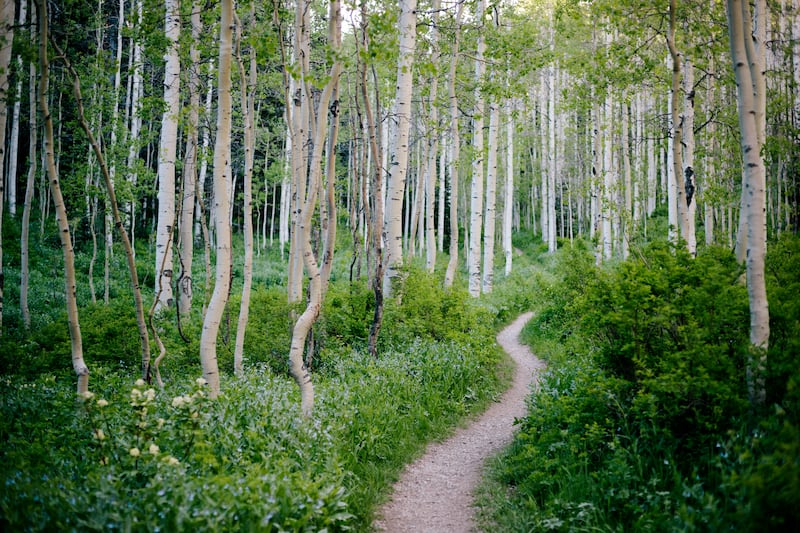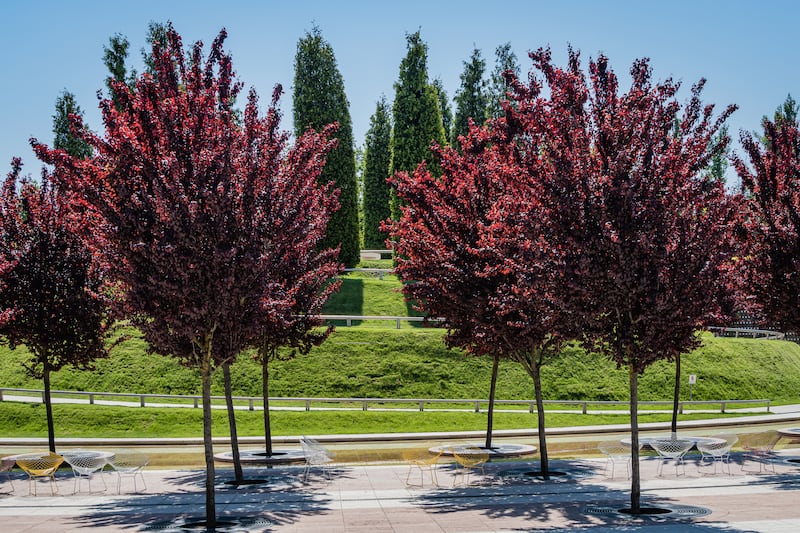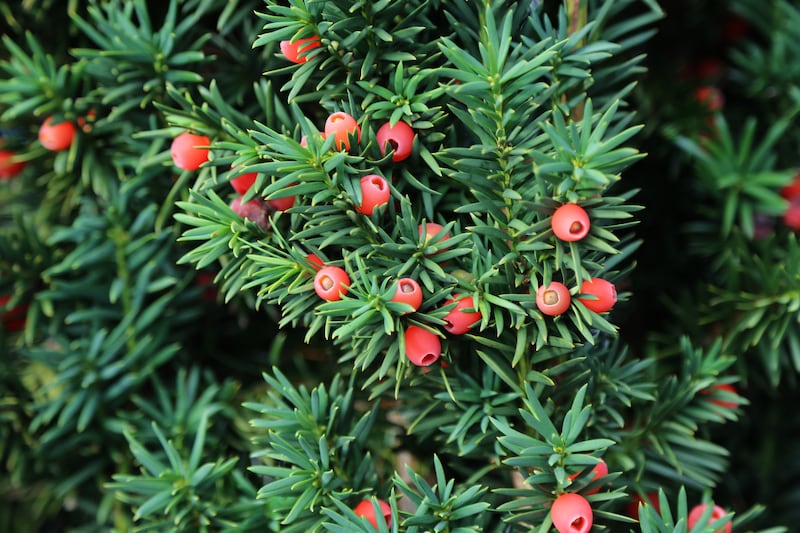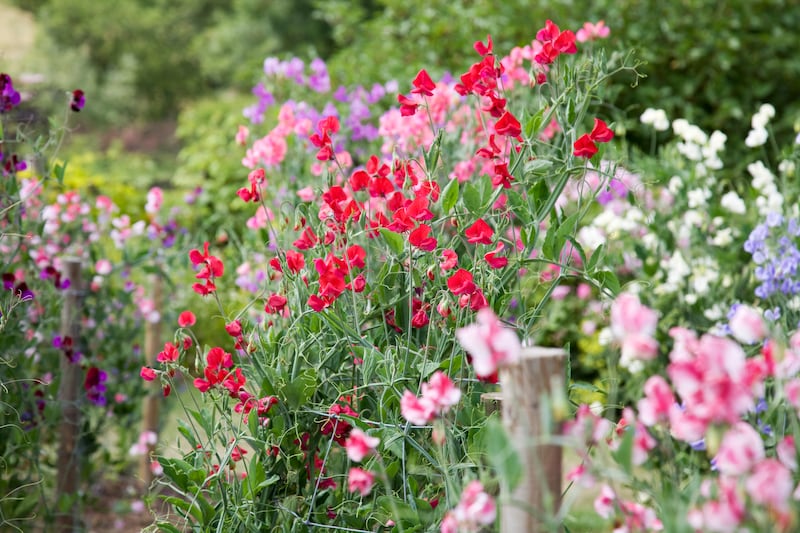Did you know that some trees (such as alder, poplar, willow, ash and the dawn redwood) can “hold their breath” when the ground in which they grow is flooded? Or that others, such as the silver lime (Tilia tomentosa), have evolved ingenious ways of conserving their water supply when confronted with extreme heat and drought, including covering their leaves with a layer of fine hairs to keep them cool in sunny weather?
Similarly, would it surprise you to learn that some trees, including evergreen species such as yew, holly and box, are far more shade-tolerant than others? This useful characteristic allows them to grow in the shady understorey beneath taller deciduous species by concentrating their growth during times of year when those deciduous trees aren’t in leaf. Other species can modify their growth according to how much light their branches receive, thus maximising their ability to harvest solar energy wherever they can. The thickness of the waxy cuticle on a beech tree’s leaves, for example, will vary greatly depending on whether those leaves are growing in deep shade (thin) or full sun (thick), while the branches growing in shade will also be elongated, and with a much more sparse leaf canopy.
Did you also know that some pioneering tree species have a magical ability to convert nitrogen in the atmosphere into a more accessible form, allowing them to grow in very harsh terrain? Examples include the black locust (Robinia pseudoacacia); sea buckthorn (Hippophae rhamnoides); and Russian olive (Eleagnus angustifolia). Tree species also vary in their ability to tolerate air, soil and light pollution, all of which can increasingly be found in our towns and cities. Our native hawthorn (Crataegus monogyna), for example, has a high tolerance of salt, but not so the lime tree (Tilia), while beech (Fagus) has a high tolerance of light pollution, unlike birch (Betula), which is sensitive to it.
A future without trees is no future at all
All very interesting, you might say, but is it of any great importance? The answer is yes and increasingly so, as The Essential Tree Selection Guide, a groundbreaking book by authors Henrik Sjöman and Arit Anderson being published by Royal Botanic Gardens Kew this month, sets out to prove. Faced with the complicated challenges of climate change, extreme weather events, urban pollution, the increased risk of pests and diseases and an ever-growing urbanised population (something like 80 per cent of Europeans now live in towns or cities), the authors argue that we need to radically re-evaluate the process by which we select the most suitable species of trees for our gardens, parks and streets. Rather than simply concentrating primarily on the sorts of aesthetic considerations which we’ve traditionally given so much weight, we instead need to look to different species’ natural habitats and environments in the wild. In this way, we can help ourselves to make the sorts of wise, site-specific, climate-appropriate choices that will optimise the chances of them flourishing into the future.
READ MORE
[ Ireland’s native trees facing danger ‘from disease and threats to gene pool’Opens in new window ]
A future without trees is, of course, no future at all. As the authors outline in depth, the variety of complex and essential roles they perform in our world is awe-inspiring, from providing clean air, food, shelter, medicine and building materials to acting as a carbon sink, supporting biodiversity, regulating extremes of temperature, and mitigating pollution, flooding and strong winds. They’re also a powerful reminder of the divine, giving us a sense of wonder while reminding us that we share this world with so many other life-forms of which we have relatively little knowledge or understanding. Confronted with the majesty of a centuries-old yew tree or sprawling oak, it’s hard not to contemplate your own mortality.
How best to choose a tree? To do that, the authors suggest you start thinking like one and use nature as your role model. This means assessing the particular site where you want to plant it on the basis of the particular species of tree’s suitability for the set of growing conditions the site will provide. That set of growing conditions includes the local climate conditions (is it a cold garden with high rainfall, for example, or a mild, seaside garden?); the microclimate (is it sunny or shady, for example, or sheltered or windy?); as well as the soil type (is it, for example, light, alkaline and free draining, or acidic, wet and heavy?). It also includes a careful consideration of how hardy the particular tree species is, and whether it’s vulnerable to certain pests and diseases – especially if the latter are already present in your garden.
If you’re planting a group of trees or a species-rich ‘pocket forest’, other primary factors include whether your choices are ‘pioneer’ species or ‘late succession’ species
A hot, dry garden, for example, is one where tree species from the steep slopes of southwestern Romania or the forests of central China will probably flourish. A large, relatively open garden with a deep, moisture-retentive soil, by comparison, is one where species of acer and oak will probably flourish. By doing everything that you can to learn about your favoured species of tree’s natural habitat and growing environment in the wild, the better informed your choice will be.
[ Ireland needs more wild native forests – not lifeless Sitka plantationsOpens in new window ]
If you’re planting a group of trees or a species-rich “pocket forest”, then other primary factors to consider include whether the trees you choose are what is known as “pioneer” species or “late succession” species. In this case, the maturity of the existing planting in your garden will decide which is most appropriate. Pioneer species, or nurse trees as they’re also known, are best suited to open, sunny growing conditions where they’ll quickly and easily create the kinds of shady woodland conditions in which late succession or longer term planting will eventually flourish.

Examples of recommended nurse trees include many different species of birch (Betula nigra, Betula pendula, Betula utilis) as well as species of acer (Acer x freemannii, Acer rubrum), alder (Alnus glutinosa, Alnus x spaethii) and prunus (Prunus avium, Prunus cerasifera, Prunus sargentii, Prunus yedoensis). Over time, some of these pioneering species can then be thinned out to make more space for longer-lived successional species such as fir trees (Abies), lime (Tilia cordata), yew (Taxus baccata) and western hemlock (Tsuga heterophylla).

Only once all of these primary elements have been considered carefully, the authors argue, should gardeners weigh up all of the other aspects that will play a role in good tree selection, from the particular species’ eventual size, growth habit, leaf, flower and bark colour to its ability to support biodiversity, regulate temperature, capture carbon and act as a windbreak.
If that sounds like a tall order, then you’ll be delighted to know that the book includes an encyclopaedic directory of more than 500 trees that are suitable for planting in what the authors refer to as the world’s temperate climates, a description that includes Ireland. This is followed by a very useful tree selection table that neatly summarises each tree species’ attributes in terms of its height and growth habit, as well as how much shade it provides, whether it’s deciduous or evergreen, how much rainfall it intercepts (another important consideration), its productive period in terms of flowers and fruit, ability to mitigate strong winds and tolerance of shade, wind, floods, drought and salt.

The authors, Sjöman, scientific curator at Gothenburg Botanical Garden, senior researcher at the Swedish University of Agriculture and honorary research associate at the UK’s Royal Botanic Gardens Kew; and Anderson, award-winning British garden designer, writer and presenter on BBC2′s Gardeners’ World, generously share their formidable knowledge of what it takes to choose the right tree for the right site with The Essential Tree Selection Guide for Climate Resilience, Carbon Storage, Species Diversity and Other Ecosystem Benefits (to give their book its full title). Beautifully illustrated, truly thought-provoking and impressively comprehensive (my only gripe is that the medlar tree, Mespilus germanica, doesn’t earn a mention), it’s a must-read for tree lovers everywhere.
This week in the garden
Use these last few beautiful Indian days of autumn to coolly assess your garden and consider ways in which the planting could possibly be improved. Would an overgrown tree or shrub benefit greatly from some judicious pruning? Might the addition of an evergreen shrub make all the difference? Where could some spring flowering bulbs be used to add seasonal colour and joy? Take a few photographs and make some notes to remind yourself.
Sow seed of sweet pea this month to give vigorous, healthy, floriferous, early-flowering plants that can be planted out into the garden next March and will start flowering in June. For best results, pre-chit the seed in a small, sealed plastic container on a bed of damp kitchen paper and place in a cool bright spot until it starts to sprout. Then very gently, take the sprouted seed and sow each one shallowly (10-15mm deep) into root trainers or small individual pots, filled with good-quality seed compost.

Dates for your diary
October 14th-21st, the inaugural National Allotments & Community Gardens Week: Growing with Nature, a week-long celebration dedicated to recognising the invaluable role of allotments and community gardens, will take place with a variety of activities and events organised around the country to mark the occasion, see cgireland.org
October 15th (9.30am-4pm), Leitrim Flowers, Anamadu Fields, Kilmacross, Co Leitrim: How to Create Seasonal Arrangements, a one-day course on creating beautiful arrangements and wreaths uses local, sustainably grown foliage and flowering bulbs, see leitrimflowers.ie

















